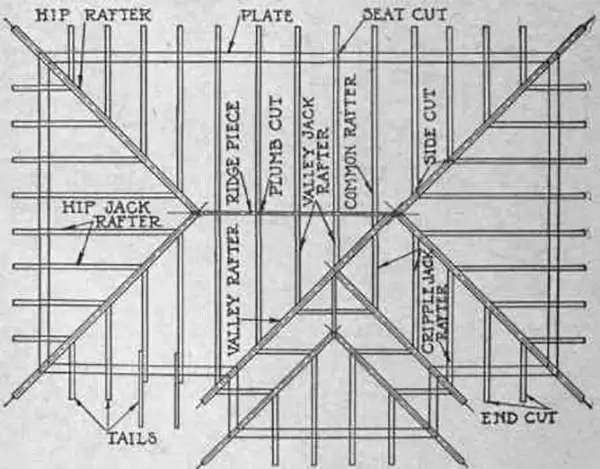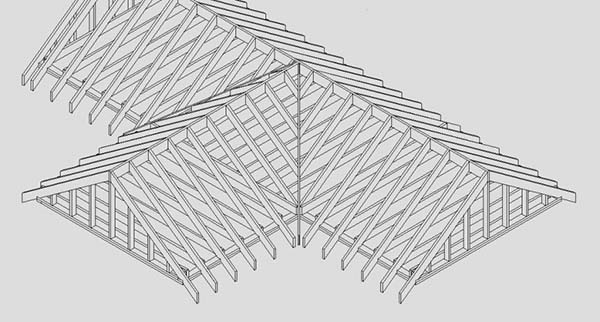One of the most important parts of building a sturdy roof is the initial roof framing plan. Roof framing simply describes how a group of rafters and beams are fitted or joined together in order to provide support for the roof covering.
Stick framing is the more common type of roof framing, accounting for 60% of all roofs. This is likely due to the fact that it is a more traditional method of framing and is less expensive than truss framing. Truss framing is a newer method of framing that uses prefabricated trusses to create the roof structure.
Contents
In order to do roof framing properly, it is important to understand the unique shape and dimensions of your roof, since these will greatly impact the geometry of the roof frame.
The two types of roof framing
Within the roofing industry, there are two basic types of roof framing:
- Stick framing
- Truss framing
Each of these utilizes a fundamentally different approach to building the roof frame.
For example, in the case of stick framing, you will use ordinary lumber for your rafters and beams, and then build the frame one beam at a time. In the case of truss framing, you will use pre-made triangular-shaped wood pieces to build the roof frame.
Thus, at the very outset, you must make a decision of whether you want to go with the traditional, more labor-intensive stick framing process, or whether you’d prefer to use the newer, less labor-intensive truss framing process.
Choosing the right frame for your roof
If you take a quick look at the various houses in your neighborhood, you’ll probably notice a variety of roof shapes. The most common of these roof types include the following: gable, hipped, mansard, gambrel and flat.
Sometimes you see a combination of two or more styles used on the same roof, such as the case of a hipped roof with a gabled dormer.
So, as you can probably imagine, each different type of roof will require a different type of roof frame. Generally speaking, the simpler the roof type, the easier it is to build a roof frame to support it.
However, even a relatively common roof type – such as the gabled roof – can be made more complex with the use of overhangs, hips and dormers.
If you think about this problem from a purely geometrical perspective, you can understand why this makes sense: each little twist or variation on a common triangle shape (i.e. the standard gable roof shape) will require additional calculations and preparation work ahead of building the frame.
As a result, it’s possible to make the following bold assertion: truss framing is really only appropriate for gable and hip roof types; for all other roof types, you should use the stick framing approach.
That’s because the truss framing approach relies on pre-made, pre-cut shapes that may or may not fit your roof’s actual dimensions. Also, if you are planning on making additions or modifications to your roof at a later date, it is preferable to use the stick framing approach.

The calculations required for roof framing
As noted earlier, roof framing is really all about getting the geometry of your roof correct. Thus, it is important to understand how each of the following calculations will impact the roof framing process:
- Span
- Rise
- Run
- Line length
- Pitch
Let’s consider each of these terms in the context of a traditional gabled roof. Span refers to the full measurement across the top of your building, from one exterior wall to the other exterior wall.
Once you know the span, you can then calculate the rise. The rise is the measurement from the center point of the span to the top of the roof. In the case of the gabled roof, this will be the “pointy tip” where there two sides of the roof meet.
Next, you can calculate the run, which is simply one-half the measurement of the span.
If you are thinking in terms of geometry and triangles, as you must when you take on a roof framing project, then the line length is simply the hypotenuse of the triangle defined by the rise and the run.
You can measure it from the exterior wall where the span ends to the very top of the rise.
The final calculation, the pitch, can be understood as the amount of angle or slope that the roof has. Mathematically, it is simply “rise over run,” telling you exactly how high a roof rises for every unit of run.
In the roofing industry, it is customary to define “rise over run” in terms of 12. This 12 corresponds to 12 inches, or 1 foot. Thus, if a pitch is 4/12 it means that the roof rises 4 inches for every 12 inches of span.
Pitch can be either shallow or steep, depending on the needs of the roof. For example, in areas of the country where snowfall is abundant, it makes sense to create a steeper pitch in order to make snow removal easier.

Measuring and cutting the rafters for the frame
If you are using the stick framing approach, you will now need to spend time measuring and cutting the rafters based on the calculations you just made.
There are several different methods for doing this, but by far, the most popular method uses the traditional framing square. Using the traditional framing square and the calculations from earlier, you can lay out the rafters appropriately.
In terms of cutting the rafters, there are three basic types of cuts that you need to know:
- Plumb cut
- Bird’s mouth cut
- Tail cut
Each of these cuts determines how two different pieces of wood will interlock and fit together to form one sturdy frame.
Conclusions on roof framing
As you can see, the initial plan for framing your roof needs to take into account several key variables, such as the shape of the roof and any relevant community building codes.
You will then have to choose between two very different types of roof framing (stick framing vs. truss framing).
Once you have done that, it’s time to make all of the precise calculations required for the pieces of wood to fit together appropriately.
The goal, of course, is for every part of your roof frame to fit together perfectly, such that you have the perfect support for your new roof.
